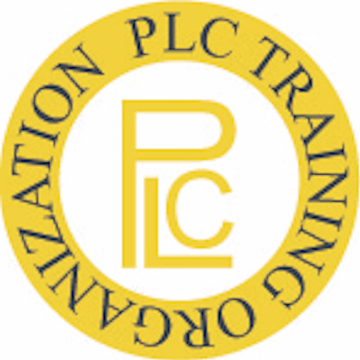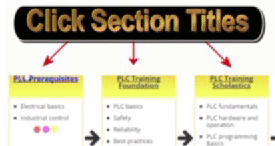Advanced Automation Training : PLC Training Best Practices

This is section 9 Advanced Automation Training of the PLC Training Best practices. Remember Industry standards are your starting point to developing best practices. Industry standards like
NFPA 79 2015; IEC 60204-1; IEC 61131-3:2013; ISA-88; ICS 21.020: 29 CFR 1910.212; ANSI/ISA99 (IEC 62443); ANSI B11.20; ANSI/RIA R15.06:2012; ISO/TS 15066:2016; ISA-84; IEC61508 & IEC61511
Below is for when you are ready to move on above and beyond Industry standards as a constant improvement program. "Advanced" is a relative term. Just like advanced automation PAC is relatively advanced compared to just learning the PLC. That is what the PLC training tip and best practices contained in these 10 sections address. This page is for Section 9 of these 10
PLC Training Tips:
- Those seeking this advanced automation training and advanced PLC training should first complete PLC training goals in sections 1-8 relevant to their occupation.
- An industrial automation related degree is necessary for most by the time they reach this point. Although not necessary for some recommendation on this page, like PID tuning when practical application approach.
- Hazardous Area Instrumentation Training.
- Equally so, getting familiar with the above standards is helpful too.
- Human Engineering training
- When tasks support is provided by the chosen programming languages, apply “Grafcet pattern” using task instead of SFC.
- Understand from the beginning learning PLCs is a journey, not just one quick course. Once you are caught up, technology and/or technique will have evolved requiring additional training or at least further education.
- More coming soon ...
Section 9: Advanced Automation Training:
The tips and best practices on this page will be helpful for ...
The maintenance manager, commercial electrician, industrial electrician, instrumentation tech, mechatronics tech, industrial engineer, industrial IT person industrial software programmer or the mechanic cross training and others.
Bookmark this page or site; as new best ways for PLC technician, industrial electrician, instrumentation technician and others to perform basics task are verified, they will be added here.
PLC Training Best Practices:
9.1 Advanced Automation Training Topics:
Besides scholastic PLC topics in manuals, the best way, the safest way and the most reliable to perform task should also be taught.
ISA-88 concepts are critical in creating modularized control software and reducing automation costs.
Understand process phases and their real world applications.
To include intro to DCS, HMI and SCADA training.
System integration.
Intro to OPC and DDE servers.
All Failure Mode Analysis Methods (RCM, FMEA, FMECA, Failure Modes Mapping)
Process trend analysis (and at least one PLC trend data historians analysis software.)
Systems Engineering for Product Life Cycle Management.
Investigate the possibilities of trend information in supervisory control and predictive maintenance programming.
Computing in respect to automation to business level interfaces. (SAS, MES, SAP, etc.)
9.2 Advanced PLC Training
Inventory all PLCs in your facility
9.2.1 Advanced PLC Instructions
MVM (masked move, masking data)
Sequencer. (sequential program flow)
Block Transfer and FIFOs shift registers (Data transfer)
Message (MSG)
PID (Proportional Integral Derivative)
FAL (File Arithmetic and Logic)
UIE/UID (User Interrupt Enable/Disable)
UDF -User Defined Function / instructions (Also called Add On Instruction AOI)
XPY (X To Power Of Y)
Motion control
9.2.2 Advanced PLC Related Training
Indirect addressing.
BCGC and ASCII numbering.
Recipe setup and usage (batch control system)
PID Tuning training.
DeMorgan's theorem
Programming using ST (Structured Text)
Programming using FBD (Function Block Diagram)
Programming using SFC (Sequential Function Chart)
Safety PLCs
9.2.3 When using a PLC in your design...
If it is a huge project you may chose a PAC instead of a PLC, and check memory size.
After writing process description, estimate I/O numbers and type needed. Then layout your task and PLC program flow.
Decide on communication needs. Both physical layout and networks.
any high speed application considerations?
More to come soon ...
9.3 Other Advanced automation Training Topics
Instrumentation Training (setting up sensors and valves, tuning and troubleshooting).
Coordinate systems
Java, API calls, XML parsing, OPC server basics
Fussy Logic
Industrial Cyber Security Management
Computer Programming.
Robotics and SERCOS protocol
Integrated vision systems
Artificial intelligence (AI)
Next ... Section 10: SCADA HMI Training Best Practices.

